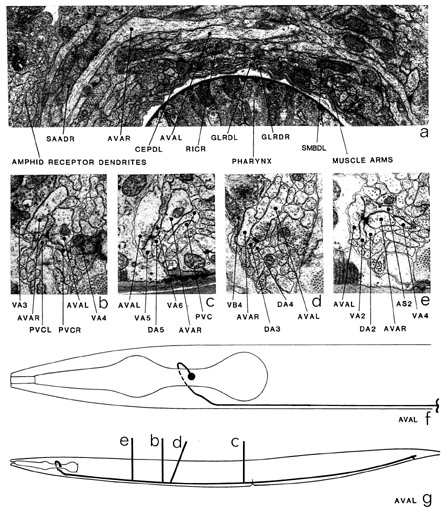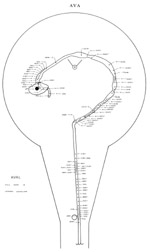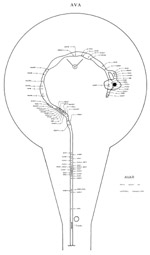 Click pictures for higher resolution images Click pictures for higher resolution images
AVA is a pair of interneurons with cell bodies situated in the lateral ganglia adjacent to the
neuropile of the nerve ring. Processes from the cell bodies enter the nerve ring laterally and
run round it, near the outside and posterior faces, to the contralateral side, eventually leaving
the ring ventrally and entering the ventral cord. They then run the length of the cord
positioned near the centre of the process bundle (figure 18), ending near
the posterior extremity of the cord in the pre-anal ganglion. The processes of AVA are rather large and lightly staining
(a); together with those of AVB they are the most prominent interneurons in the ventral cord.
In the nerve ring they are exclusively postsynaptic and receive extensive synaptic input. The
main presynaptic partners in this region are: SAA (*b), FLP (*a), RIC (*a), DVC (*c), PVP (*c), AUA (*c), ASH (*b), AQR (*c), ADL (*d), SDQ (*b), DVA (*c) and RIB (*g); there
are gap junctions to RIM, URY and itself (a). In the ventral cord AVA is both pre- and
postsynaptic, although the chemical synapses that it makes have rather few vesicles (b, c, d,
e). The main synaptic output is to the ventral cord motoneurons: VAn (c), DAn (d), ASn (e) and also to PVC (b) and SAB. PVC (*g), VAn (*b), DAn (*c), ASn (*c) and SAB (*c)
have gap junctions with AVA. There is considerable synaptic input from AVD (*a), AVE (*a)
and AVB (*b) distributed along the length of the cord as well as some less extensive input from PVC (*f), ADE (*b) and PLM (*f). In the pre-anal ganglion, AVA receives synapses from PHB (*a), PQR (*g) and LUA (*a).
Magnifications: (a-e) x 17000.
AVA ventral cord synapses (MoW Table Guide)
partners |
gap junctions |
synapses from |
synapses to and corecipients |
PVC |
10 |
3+11 m |
7, 5LUA, 4PVC, 4DA8, 2PDE, VA10, DB5, VA4, DB3, DA7, DA5 |
VA11 |
8 |
- |
6AS11, 3DA8, 2DA9, VA12, VA10, VD13 |
DA8 |
1 |
- |
4PVC, 3VA11, 2AS11, VA12, DA7, DA9, VA10, VD13 |
DA4 |
5 |
- |
3, 4DA3, 2DA5, 2VA3, VA4 |
VA10 |
2 |
- |
1, 3AS10, 2DA7, PVC, VA11, AS11, DA8 |
DA5 |
5 |
- |
2, 3V A5, 2DA4, PVC, DA6 |
DA3 |
2 |
- |
2, 4DA4, 2DA2, VA3 |
AS11 |
- |
- |
6VA11, 2DA8, VA10 |
DA7 |
2 |
- |
2AVA, 2VA10, AS10, DA8, PVC |
VA5 |
6 |
- |
3DA5, V A6, AS6, DA6 |
LUA |
- |
1 + 19 m |
5PVC |
DA9 |
- |
- |
2, 2VA11, DA8 |
AS5 |
2 |
- |
3VA6, AVB |
DA1 |
8 |
- |
2, AVA, SABD |
AS10 |
1 |
- |
3VA10, DA7 |
VA4 |
3 |
- |
PVC, DA4, AS4, DB3 |
DA2 |
3 |
- |
1, 2DA3, AVE |
VA6 |
5 |
- |
3AS5, VA5 |
VA3 |
3 |
- |
1, 2DA4, DA3 |
AVE |
- |
8+30 m |
2AS3, AS1, DA2 |
AVA |
4 |
3m |
2DA7, DA1 |
VA2 |
3 |
- |
1, 2AS2 |
AS2 |
- |
- |
1, 2VA2 |
AVD |
- |
7 +56 m |
SABV, AS6 |
DB5 |
2 |
- |
1, PVC |
VA12 |
1 |
- |
DA8, VA11 |
SABV |
4 |
- |
1,AVD |
AS6 |
2 |
- |
VA5, AVD |
AS4 |
- |
- |
1, VA4 |
VD13 |
- |
2m |
DA8, VA11 |
DB3 |
- |
- |
PVC, VA4 |
DA6 |
- |
- |
DA5, VA5 |
PDE |
- |
- |
2 PVC |
AVB |
- |
21+6 m |
1, AS5 |
AS3 |
3 |
- |
2AVE |
SABD |
4 |
- |
DA1 |
AS1 |
4 |
- |
AVE |
PHB |
- |
21 m |
- |
PQR |
- |
5 + 14 m |
- |
FLP |
- |
3+14m |
- |
PLM |
- |
1+4m |
- |
PVN |
- |
2+4m |
- |
AVJ |
2 |
2m |
- |
PVD |
- |
3m |
- |
VD11 |
- |
2 |
- |
AVG |
- |
1+1m |
- |
VA7 |
5 |
- |
- |
VA1 |
2 |
- |
- |
VA5 |
1 |
- |
- |
DA2 |
1 |
- |
- |
VA8 |
1 |
- |
- |
BDU |
- |
2m |
- |

|
|

Click pictures for higher resolution images



